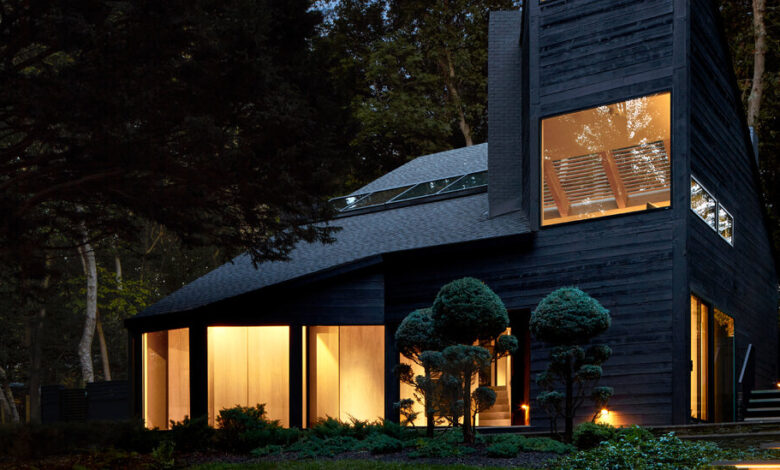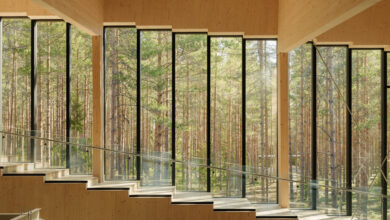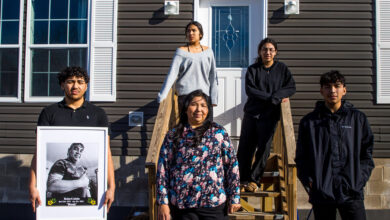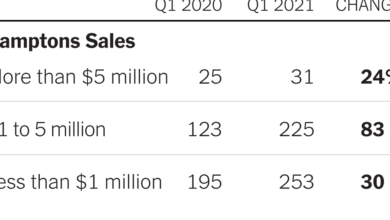In the Hamptons, a Modern Home Fit for a Bond Villain

The experimental midcentury-modern architecture of the Hamptons has long been a source of fascination to many in the design world — including Timothy Godbold, an interior designer based in Southampton, N.Y. So in the fall of 2019, when he noticed an unusual modernist house in town listed for sale, he was intrigued.
More intriguing still: It was built in 1973 by Eugene L. Futterman, a name he didn’t recognize.
The 1,700-square-foot home was all angles, with two intersecting, triangular roof planes and a primary bedroom that rose into the treetops like a periscope. But the interior was dated and the weathered-cedar exterior had been repaired with mismatched boards, so the house had languished on the market. “It was really quirky, and it was a really good price,” Mr. Godbold, 55, said.
“The minute I saw it, I thought, ‘Oh, this is going to be a black house,’” he continued. “The shape of the house was so incredible, but the different shades of wood were distracting to the eye. Painting it a solid color brought the architecture together.”
The asking price was $925,000, but he offered substantially less and closed for $832,500 in January 2020.
Several months later, Mr. Godbold established Hamptons 20 Century Modern, an organization dedicated to preserving modern houses in the area. But in his own home, he wasn’t beholden to the past.
After moving in, he began planning an overhaul of the interior and the grounds. His goal: to combine the feeling of his architecturally ambitious childhood home in Perth, Australia, with the vibe of a villain’s hide-out from a James Bond movie.
“I’ve always been obsessed with James Bond villain lairs,” Mr. Godbold said, citing the movies “Thunderball” and “Moonraker” as sources of inspiration.
“I’m not married. I don’t have a partner saying, ‘No, honey, don’t do that,’” he explained. “It’s just me, so I can do whatever I want.”
Leading up to the house, he designed a series of cantilevered bluestone steps that wind through the garden and are lit from below, so they appear to hover on light. Also, they conceal integrated speakers. “I can create whatever mood I want,” he said. “If I’m having a party and want ’70s disco, it’ll be in the staircase.”
The round steel firepit is ringed by a terrace finished in sections of small and large black-pebble mosaic — a design based on “the nuclear symbol,” Mr. Godbold said, which also reminds him of Charlotte Perriand’s Rio coffee table.
In the living room, he installed a short wall that’s angled so it looms over a snaking 1960s sectional sofa upholstered in nubby white wool. A large planter filled with monstera plants sits atop the wall. Below, the existing fireplace has a new profile recalling a stepped pyramid.
“It’s based on ‘Moonraker,’” he said. “Remember when he goes to Brazil and he’s coming into the lair and there are all the angular walls?”
But the living room isn’t a homage just to 007. “That’s also Paul Rudolph,” Mr. Godbold said, naming the revered 20th-century American architect known for his geometric constructions. “He’s one of my idols.”
For light switches and dimmers, Mr. Godbold chose metal toggle switches and knurled knobs from Buster & Punch that look capable of triggering machine guns or ejector seats.
Of course, few well-funded villains build lairs solely for the purpose of orchestrating dastardly deeds. Luxury is usually a priority, and Mr. Godbold made sure not to fall short on that count. In the primary bedroom, he placed his bed on a carpeted riser with lighting underneath it and Belgian linen drapery surrounding it, for the feeling of a cocoon. Then he knocked down a wall to open the space to his bathroom, where he added ribbed fibrous cement panels from Equitone to the walls and a soaking tub set beneath skylights.
For one of the two guest rooms, he designed a custom stainless-steel bed with a smoky gray travertine headboard and a built-in desk as the footboard. In the dining room, he created a table by placing a custom terrazzo top on a planter from West Elm — “a $10,000 stone top on a $400 base.”
Although he splurged on a few special pieces, Mr. Godbold pinched pennies elsewhere. To keep renovation costs down to about $350,000, he lived in the house during the 18-month project, which he completed last August, and served as his own general contractor.
“I had no kitchen — just a microwave and paper plates and cups,” he said. “But I did it, and it was great.”
He estimates the house may be worth twice what he spent on it. “No one wanted this house,” he said. “It had been sitting on the market. But I knew exactly what I was going to do when I saw it.”
If others follow his example, he added, “I hope they have as much fun as I did.”
For weekly email updates on residential real estate news, sign up here.
Source link






